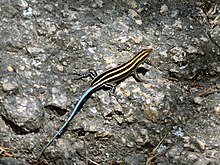Nucras
Appearance
| Nucras | |
|---|---|

| |
| Nucras caesicaudata | |
| Scientific classification | |
| Domain: | Eukaryota |
| Kingdom: | Animalia |
| Phylum: | Chordata |
| Class: | Reptilia |
| Order: | Squamata |
| Family: | Lacertidae |
| Subfamily: | Lacertinae |
| Genus: | Nucras Gray, 1845[1] |
| Species | |
|
See text. | |
Nucras is a genus of African lacertid lizards, commonly called sandveld lizards.[2]
Species
The following 12 species are recognized as being valid.[3]
- Nucras aurantiaca Bauer, Childers, Broeckhoven, and Mouton, 2019[4]
- Nucras boulengeri Neumann, 1900 - Uganda savannah lizard, Boulenger's scrub lizard
- Nucras broadleyi Branch, Conradie, Vaz-Pinto, & Tolley, 2019 - Angolan sandveld lizard
- Nucras caesicaudata Broadley, 1972 - bluetailed sandveld lizard, bluetail scrub lizard
- Nucras holubi (Steindachner, 1882) - Holub's sandveld lizard
- Nucras intertexta (A. Smith, 1838) - spotted sandveld lizard
- Nucras lalandii (Milne-Edwards, 1829) - Delalande's sandveld lizard, Laland's lizard, Delalande's spotted lizard
- Nucras livida (A. Smith, 1838) - Karoo sandveld lizard
- Nucras ornata (Gray, 1864) - ornate sandveld lizard, ornate scrub lizard
- Nucras scalaris Laurent, 1964 - scaled sandveld lizard
- Nucras taeniolata (A. Smith, 1838) - Albany sandveld lizard, striped scrub lizard
- Nucras tessellata (A. Smith, 1838) - western sandveld lizard, striped sandveld lizard, tiger lizard, striped sand lizard, banded sand lizard
Nota bene: A binomial authority in parentheses indicates that the species was originally described in a genus other than Nucras.
References
- ^ "Nucras ". Dahms Tierleben. www.dahmstierleben.de/systematik/Reptilien/Squamata/Scincomorpha/Lacertidae.
- ^ Branch, Bill (2004). Field Guide to Snakes and other Reptiles of Southern Africa. Third Revised edition, Second impression. Sanibel Island, Florida: Ralph Curtis Books. 399 pp. ISBN 0-88359-042-5. (Genus Nucras, p. 167-168; species of Nucras, pp. 168-170).
- ^ "Nucras ". The Reptile Database. www.reptile-database.org.
- ^ Mouton, P. Lefras N.; Broeckhoven, Chris; Childers, Jackie L.; Bauer, Aaron M. (2019-02-22). "A new Nucras Gray, 1838 (Squamata: Lacertidae) from the Strandveld of the Western Cape, South Africa". Zootaxa. 4560 (1): 149–163. doi:10.11646/zootaxa.4560.1.8. ISSN 1175-5334.
Further reading
- Bischoff W (1991). "Übersicht der Arten und Unterarten der Familie Lacertidae 4. Die Gattungen Latastia, Meroles, Nucras, Ophisops, Pedioplanis und Philocortus". Die Eidechse 2 (4): 17–25. (in German).
- Gray JE (1845). Catalogue of the Specimens of Lizards in the Collection of the British Museum. London: Trustees of the British Museum. (Edward Newman, printer). xxviii + 289 pp. (Nucras, new genus, p. 33).
